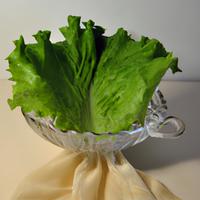
1 serving (50 grams) contains 8 calories, 0.6 grams of protein, 0.1 grams of fat, and 1.5 grams of carbohydrates.

Log this food in SnapCalorie

Nutrition Information
Calories |
16 | ||
|---|---|---|---|
% Daily Value* |
|||
| Total Fat | 0.2 g | 0% | |
| Saturated Fat | 0.0 g | 0% | |
| Polyunsaturated Fat | 0 g | ||
| Cholesterol | 0 mg | 0% | |
| Sodium | 10 mg | 0% | |
| Total Carbohydrates | 3 g | 1% | |
| Dietary Fiber | 1.2 g | 4% | |
| Sugars | 1 g | ||
| protein | 1.2 g | 2% | |
| Vitamin D | 0 mcg | 0% | |
| Calcium | 36 mg | 2% | |
| Iron | 0.6 mg | 3% | |
| Potassium | 250 mg | 5% | |
* Percent Daily Values are based on a 2,000 calorie diet. Your daily values may be higher or lower depending on your calorie needs.
Food Attributes
Source of Calories
About Outer lettuce leaves
Outer lettuce leaves are the sturdy, often darker green portions found on the exterior of a head of lettuce. These leaves are rich in fiber, aiding in digestion, and are packed with essential vitamins such as A, C, and K, which support vision, immune health, and blood clotting. They also contain folate, a key nutrient for cell function and development, and minerals like potassium and magnesium. Typically more nutrient-dense than the softer inner leaves, outer lettuce leaves are a versatile ingredient in global cuisines, commonly used in fresh salads, wraps, or as a garnish. Their slightly tougher texture makes them perfect for adding crunch to dishes. While low in calories and naturally fat-free, they can lose some of their nutritional value when paired with heavy dressings or toppings. For maximum benefit, enjoy them raw and minimally processed.



